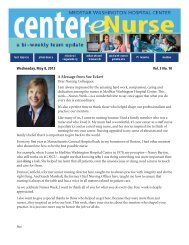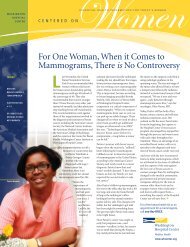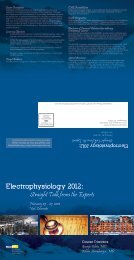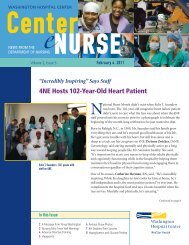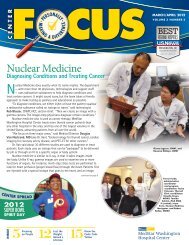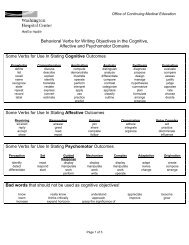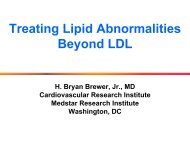Emerging LVAD Technology for the Use - Washington Hospital Center
Emerging LVAD Technology for the Use - Washington Hospital Center
Emerging LVAD Technology for the Use - Washington Hospital Center
Create successful ePaper yourself
Turn your PDF publications into a flip-book with our unique Google optimized e-Paper software.
<strong>Emerging</strong> <strong>LVAD</strong> Technologies <strong>for</strong> <strong>the</strong><br />
<strong>Use</strong> of Life Long Mechanical Support<br />
Steven W. Boyce, MD<br />
Surgical Director, Advanced Heart Failure Program<br />
MedStar Heart Institute<br />
MedStar <strong>Washington</strong> <strong>Hospital</strong> <strong>Center</strong>
Disclosures<br />
• Stocks, Stock Options, o<strong>the</strong>r Ownership<br />
Interest:<br />
• Heartware<br />
• Thoratec<br />
• My discussion will include off-label<br />
discussions.<br />
• These devices are not yet FDA<br />
approved
Continuous Flow <strong>LVAD</strong>s<br />
• Thoratec VADs<br />
• HeartMate ® II LVAS<br />
• HeartMate ® III LVAS<br />
• HeartMate ® X<br />
• HeartWare Ventricular Assist Systems<br />
• HVAD ® pump<br />
• MVAD pump<br />
• Jarvik 2000 ® <strong>LVAD</strong><br />
• MicroMed CardioVascular HeartAssist 5 ®<br />
• CircuLite ® Synergy ® MicroPump
Second Generation Axial Flow Pumps<br />
Physiology<br />
• Adequate end-organ perfusion (Russell et al, J Heart Lung<br />
Transplant 2006)<br />
• No detrimental effects on cerebral perfusion or<br />
pulmonary function (Thalmann et al, J Heart Lung Transplant 2005)<br />
• Attenuation of neurohormones, inflammatory<br />
markers, cellular hypertrophy (Thohan et al, J Heart Lung<br />
Transplant 2006)<br />
• ↓ allosensitization and fewer post-transplant<br />
rejections (George et al, J Heart Lung Transplant 2006)<br />
• Fewer driveline infections (Hipkin et al, J Heart Lung Transplant<br />
2006)<br />
• Adequate support with exercise (Thalmann et al, J Heart Lung<br />
Transplant 2005)<br />
• Improved QOL (Miller et al, CHF 2004)
• Electrically powered<br />
• Percutaneous driveline<br />
• Flow range 3-10 l/min<br />
• FDA Approved<br />
HeartMate II <strong>LVAD</strong><br />
– Bridge to Transplantation<br />
– Destination Therapy<br />
• Clinical Experience<br />
– Over 1000 patients<br />
implanted<br />
– Over 7000 pt-years of<br />
support
• Continuous flow, rotary pump<br />
• Axial design<br />
• Small<br />
HeartMate II <strong>LVAD</strong><br />
• 1/7 th size (65 cc displacement)<br />
• 1/4 th weight (295 gm)<br />
• Quiet operation<br />
• No requirement <strong>for</strong> venting<br />
• 40% smaller percutaneous lead<br />
• Single internal moving part<br />
• Potential <strong>for</strong> long-term durability
• FDA approved<br />
Thoratec HeartMate II LVAS<br />
– Bridge to transplant – 2009<br />
– Destination Therapy – 2010<br />
• Clinical Experience<br />
– > 10,000 implants worldwide<br />
– Patients supported ≥ 3 years: 455<br />
– Patients supported ≥ 4 years: 158<br />
– Patients supported ≥ 5 years: 43<br />
– Patients supported ≥ 6 years: 14<br />
0<br />
– Patients supported ≥ 7 years: 2 Months<br />
Percent Survival<br />
100<br />
90<br />
80<br />
70<br />
60<br />
50<br />
40<br />
30<br />
20<br />
10<br />
Implant dates n 30 d 6 Mo 12 mo<br />
a Apr ’08 - Oct ‘10 1496 95% 89% 85%<br />
b Apr ’08 - Aug ‘08 169 96% 90% 85%<br />
c Mar ’07 - Apr ‘08 205 95% 86% 80%<br />
d Mar ’05 - Mar ‘07 281 92% 82% 73%<br />
e Mar ’05 - May ’06 133 89% 75% 68%<br />
a John et al STS 2011<br />
b Starling et al JACC (in press)<br />
d Pagani et al JACC 2009<br />
e Miller et al NEJM 2007<br />
0 6 12<br />
Late Trial c<br />
Post-Trial a<br />
Post-Approval Study b<br />
Early-mid Trial d<br />
Early Trial e
Percent Survival<br />
100<br />
90<br />
80<br />
70<br />
60<br />
50<br />
40<br />
30<br />
20<br />
10<br />
0<br />
Improving Survival in <strong>LVAD</strong> Trials<br />
HM II BTT Starling HFSA 2009<br />
0 6 12 18 24<br />
Months<br />
HM II BTT Pagani JACC 2009<br />
HM II BTT Miller NEJM 2007<br />
HM II DT Slaughter NEJM 2009<br />
VE DT <strong>LVAD</strong> REMATCH Rose NEJM 2001<br />
XVE DT <strong>LVAD</strong> Slaughter NEJM 2009<br />
Novacor DT <strong>LVAD</strong> INTrEPID Rogers JACC 2007<br />
OMM REMATCH Rose NEJM 2001<br />
OMM INTrEPID Rogers JACC 2007
Thoratec HeartMate III<br />
• Full-magnetic levitation:<br />
allows precise rotor<br />
control → ability to<br />
develop pulsatile flow<br />
• Textured bloodcontacting<br />
surfaces<br />
• Intra-thoracic placement<br />
• Modular percutaneous<br />
lead (driveline)
Thoratec HeartMate III<br />
Large pump gaps<br />
View Inside <strong>the</strong> Pump<br />
Chamber<br />
Low Shear Stress<br />
Rotor<br />
Textured surfaces<br />
inside pump<br />
chamber
*In development and not available <strong>for</strong> clinical use<br />
Thoratec HeartMate X*<br />
• Leverages HMII bearing<br />
technology – projected 17<br />
year lifespan<br />
• Capable of full or partial<br />
support<br />
• Versatile cannulation –<br />
RVAD/BVAD<br />
• Lower power consumption –<br />
potential <strong>for</strong> smaller external<br />
batteries and components
Implanted<br />
Controller/Battery/<br />
Advanced Energy<br />
Transmission (TETS)<br />
Module<br />
Thoratec Fully-Implantable LVAS<br />
*In development and not available <strong>for</strong> clinical use<br />
• Advanced wireless energy<br />
transfer<br />
– Eliminates <strong>the</strong><br />
percutaneous lead<br />
− WiTricity’s distance<br />
enhancing, wireless<br />
electricity transmission<br />
technology (no TET coils)<br />
• Advanced battery technology<br />
– ~3 hours initially and ~ 2<br />
hours at 3 year mark<br />
• Implanted components with<br />
highly reliable electronics
HeartWare Ventricular Assist System<br />
• Centrifugal design: hybrid magnetic/hydrodynamic impeller<br />
suspension<br />
• Intrapericardial placement – no abdominal surgery or pump<br />
pocket<br />
• Accurate flow estimation<br />
• 4.2 mm flexible driveline with fatigue resistant cables
Pericardial Placement Advances Therapy<br />
HeartMate XVE<br />
HVAD Pump<br />
HeartMate II<br />
Thoratec<br />
HeartMate XVE<br />
Thoratec<br />
HeartMate II<br />
HeartWare<br />
HVAD Pump
HeartWare Ventricular Assist System<br />
International Trial<br />
• Enrolled: 50 patients at 5 <strong>Center</strong>s<br />
• Completed: June 2008<br />
• CE Mark and TGA approval<br />
ADVANCE FDA Bridge to Transplant Trial<br />
• Enrolled: 140 patients at 30 centers<br />
• PMA: filed December 2010<br />
• CAP (Continued Access Protocol): enrolled 202 additional patients<br />
ENDURANCE FDA Destination Therapy Trial<br />
• Enrolled: 430+ patients (target 450)<br />
• Target Enrollment Completion: 2Q12<br />
REVIVE-IT Trial<br />
• NHLBI sponsored trial of HVAD Pump in Class III patients<br />
• Enrollment target: 100 patients in ten centers<br />
• Anticipate enrollment beginning 2012
HeartWare Ventricular Assist System<br />
Results from Pivotal ADVANCE BTT Trial<br />
• Enrollment of 140 patients, completed February 28, 2010<br />
• Study cohort “Success” was 92%<br />
• Non-inferiority to INTERMACS control group (p < 0.0001)<br />
• Overall survival was 94% at 180 days and 91% at 360 days<br />
• 30-day mortality was 1.4%<br />
• Favorable adverse event profile<br />
• Results filed with <strong>the</strong> FDA December 27, 2010
Sintered HVAD Inlet
HeartWare Ventricular Assist System<br />
Potential Future Indications <strong>for</strong> <strong>the</strong> HVAD ® pump<br />
Potential <strong>for</strong> right or bi-ventricular<br />
support<br />
E. McGee, Northwestern<br />
NOTE: The HVAD Pump is not-indicated <strong>for</strong> right ventricle or pediatric use<br />
Potential pediatric and uni-ventricular<br />
support<br />
M. Hubler, German Heart Institute, Berlin
HeartWare MVAD<br />
• Wide blade impeller<br />
with hybrid suspension<br />
• Significant<br />
miniaturization - ⅓<br />
size of HVAD<br />
• Partial and full flow support<br />
• Potential <strong>for</strong> right and left<br />
ventricular support (RVAD/<strong>LVAD</strong>)
Heartware MVAD
HeartWare MVAD<br />
Trans-Mitral “MVAD”: Right Thoracotomy<br />
• Inflow cannula through upper right<br />
pulmonary vein or LA <strong>the</strong>n across<br />
mitral valve to access LV<br />
• Outflow graft to ascending aorta<br />
• Benefits: no myocardium<br />
incisions, no bypass, mitral<br />
valve always opens<br />
• Questions: procedure<br />
acceptance, mitral valve<br />
integrity
HeartWare MVAD<br />
Trans-Apical “MVAD”: Left Thoracotomy<br />
• Device in LV with inflow<br />
pointing toward apex<br />
• Outflow in ascending aorta<br />
• Benefits: very quick<br />
implantation, no outflow<br />
graft, no bypass<br />
• Questions: device in LV,<br />
aortic valve integrity
• Intraventricular axial flow pump<br />
• CE Mark 5/05<br />
• US BTT IDE Pivotal Study<br />
Jarvik 2000 ® VAS<br />
• 150 patient enrollment completed<br />
in 2011<br />
– Study enrollment will continue up<br />
to maximum of 160 subjects<br />
– Pilot and Pivotal cohorts total 213 subjects<br />
– Continuing Access Protocol (CAP) application in Q1<br />
2012<br />
– PMA application to be submitted in 2012
Jarvik 2000 ® VAS<br />
Destination Therapy Study:<br />
• IDE Study Protocol: in discussions with<br />
<strong>the</strong> FDA<br />
• Target initiation in 2012<br />
• Study design: prospective,<br />
randomized against an<br />
approved DT <strong>LVAD</strong><br />
• Study implant technique will include <strong>the</strong><br />
Post-Auricular version of <strong>the</strong> Jarvik 2000 ®<br />
VAS
Future applications<br />
• Total Ventricular Assist<br />
(TVA or BVAD)<br />
applications<br />
RV & LV support in<br />
children<br />
RV support in adults<br />
Jarvik 2000 ® VAS
MicroMed HeartAssist 5 ® VAD<br />
• Axial flow device (92 grams)-<br />
implant above <strong>the</strong><br />
diaphragm.<br />
• Implantable Flow Probe<br />
• HeartAssistRemote<br />
Monitoring System<br />
• 2 VAD Sizes – allows<br />
different size patient<br />
anatomies.<br />
– US IDE BTT Trial<br />
• In discussion with <strong>the</strong> FDA<br />
• Target multi-center study in<br />
2012
MicroMed HeartAssist 5 ® VAD<br />
HeartAssistRemote Monitoring<br />
• Allows <strong>for</strong> monitoring of speed, flow and power over <strong>the</strong><br />
internet, which facilitates earlier intervention<br />
• Partnership w/ Global Network of 900 Carriers
CircuLite ® Synergy ® Micro-Pump<br />
• Miniaturized, implantable axial flow<br />
blood pump<br />
• Minimally invasive: off-pump,<br />
subcutaneous (extrathoracic)<br />
pacemaker-like “pocket” placement<br />
• NYHA Class IIIb and early IV patients<br />
• Provides 1.50-4.25 L/min blood flow<br />
• Designed <strong>for</strong> long-term support<br />
– Bench-top testing >3.5+ years<br />
• Clinical experience in 44 patients
CircuLite ® Synergy ® Micro-Pump<br />
• Initial issues: pump thrombosis and graft<br />
weeping resolved → reduction in anticoagulation<br />
<strong>the</strong>rapy<br />
• Synergy ® EU Clinical Study ongoing<br />
• 44 patients implanted<br />
• Demonstrated sustained improvements in<br />
hemodynamics, functional status and<br />
quality of life<br />
• Longest patient supported > 2.5+ years<br />
• Six patients supported <strong>for</strong> >1 year<br />
• CE Mark approval anticipated in 2012<br />
• US IDE pilot trial anticipated 2012
“May I be<br />
excused? My<br />
brain is full.”
Potential VAD Patient Opportunity<br />
US Population [1] 301,000,000<br />
Target Population – 35-74 Age Cohort [1] 139,100,000<br />
Diagnosed CHF Population [2]<br />
All ages 5,520,000<br />
35 to 74 years 3,744,000<br />
NYHA Class IIIB and IV [3] in 35 – 74 Age Cohort 374,400<br />
(75%)<br />
Co-morbidities estimated in this Cohort (280,800)<br />
Target VAD Patient Population – 35 to 74 years 93,600<br />
Estimated VAD patient per 100,000 30<br />
[1] US Census Bureau Statistics (2008)<br />
[2] Heart and Stroke Statistics, American Heart Association (2008)<br />
[3] Cardiovascular Roundtable research and analysis, The Advisory Board Company (2008)
VAD Implants in <strong>the</strong> 20 Largest Metro Areas (US Only)<br />
Implants per 100,000<br />
2.50<br />
2.00<br />
1.50<br />
1.00<br />
0.50<br />
0.00
Are We Ready?
Intracorporeal BVADs <strong>for</strong> DT<br />
• Size less invasive implant<br />
• Right sided support: RVAD<br />
• Integrated BVAD—one controller<br />
– In future may allow pts with RVF/sicker pts<br />
Heartware MVAD<br />
HeartMate X
HeartWare Ventricular Assist System<br />
• HVAD miniaturized implantable blood pump<br />
– Pericardial placement – no pump<br />
pocket<br />
– Provides up to 10 L/min of flow<br />
– Centrifugal design, continuous flow<br />
– Hybrid magnetic / hydrodynamic<br />
impeller suspension<br />
– Optimizes flow, pump surface washing,<br />
and hemocompatibility<br />
• Thin (4.2 mm), flexible driveline with<br />
fatigue resistant cables
A Permanent, Partial Support <strong>LVAD</strong>: Potential <strong>for</strong><br />
Minimally Invasive Implantation<br />
Pump to <strong>the</strong><br />
Subclavian<br />
Artery<br />
Subcutaneous<br />
pump,<br />
implanted like<br />
a pacemaker<br />
CircuLite<br />
Take Blood<br />
From LA
Fully-Implantable System: Energy Transmission<br />
<strong>Technology</strong><br />
• Efficient energy transfer system under development<br />
• <strong>Technology</strong> being optimized to minimize coil alignment<br />
sensitivity and maintain high efficiency<br />
• The proprietary approach is being developed <strong>for</strong> <strong>the</strong> VAD<br />
application under an technology agreement with WiTricity<br />
Corporation
HeartWare Ventricular Assist System<br />
Clinical Update at EACTS 2011<br />
• 241 patients followed in ADVANCE and CAP with at least 6 months of follow<br />
up <strong>for</strong> 207 patient-years of support<br />
• Average duration of support: 313 days<br />
• Survival remains high at 92.7% at 180 days despite lower transplant rate than<br />
in prior BTT trials<br />
• Reoperations <strong>for</strong> bleeding as well as sepsis and driveline infections were<br />
infrequent<br />
• Focus on anti-platelet reduced thrombus events without increasing bleeding<br />
• Overall, adverse event rates remain low despite prolonged exposure to device<br />
support with improving survival and lower transplant rates
• GLP animal studies completed<br />
HeartWare MVAD<br />
• MVAD CE Mark study planned <strong>for</strong><br />
1H12, with 50 patients at 6-8 clinical<br />
sites<br />
• US IDE to commence after initial CE<br />
Mark patients are implanted



